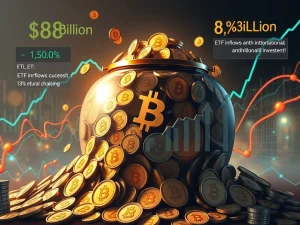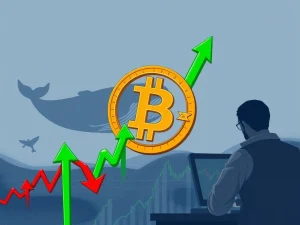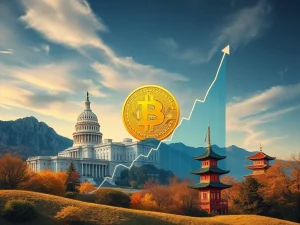Bretton Woods Institutions Face Urgent Call for Reorientation Amid Global Monetary Shift

Hold onto your hats, crypto enthusiasts. The very foundations of the global financial system are under scrutiny, and what happens next could significantly impact the world of digital assets, including Bitcoin and stablecoins. A top US official is signaling that major institutions born from the historic Bretton Woods agreement need a serious overhaul.
Bretton Woods Institutions Must Reorient, Says US Treasury Secretary
United States Treasury Secretary Scott Bessent recently made a notable call for the “Bretton Woods institutions,” specifically mentioning the International Monetary Fund (IMF) and the World Bank, to undergo a reorientation. Speaking at the Institute of International Finance (IIF) on April 23, Bessent stated that these pivotal organizations must refocus their efforts.
According to Bessent, the core mission should involve correcting trade imbalances between nations and actively protecting the value of fiat currencies from exchange rate volatility. He emphasized:
- Bretton Woods institutions should move away from “sprawling and unfocused agendas.”
- The IMF’s original mandate includes promoting international monetary cooperation, facilitating balanced trade growth, encouraging economic growth, and discouraging harmful policies like competitive currency devaluation.
This directive from the US Treasury Secretary suggests a potential shift in how these global financial bodies operate, focusing more narrowly on fundamental economic stability issues.
Why the Focus on US Dollar Stability and Trade Imbalances?
Bessent’s comments arrive at a time of significant economic headwinds for the United States. The call for the IMF to address trade imbalances, particularly between the US and China, coincides with several concerning indicators:
- The US dollar has recently dropped to three-year lows against other major currencies, as measured by the Dollar Currency Index (DXY).
- The US government debt currently stands at a staggering $36 trillion.
- Economic competition from countries like China continues to intensify.
Veteran investor Ray Dalio has argued that the world is currently navigating a major macroeconomic transition. He believes this shift could eventually dismantle the post-WWII financial order and potentially displace the US dollar as the world’s primary reserve currency, possibly paving the way for a digital form of money.
Understanding the Bretton Woods Agreement and Its Legacy
To fully grasp the significance of Bessent’s remarks, it helps to look back at the origins of the institutions he mentioned. The Bretton Woods Agreement, signed in 1944, was a landmark moment in global finance.
The agreement pegged the currencies of 44 countries to the value of the US dollar, which itself was pegged to gold at a fixed rate ($35 per ounce). The main goal was to simplify international trade by eliminating the complex exchange rate risks associated with freely floating currencies.
However, this system changed dramatically in August 1971 when US President Richard Nixon announced the temporary suspension of the dollar’s convertibility to gold. This move, often called the “Nixon Shock,” effectively ended the Bretton Woods system as it was originally designed. Despite this, the IMF and the World Bank, created under the agreement, continued to operate, attempting to manage the effects of free-floating fiat currencies on the global foreign exchange market.
Stablecoins vs. Bitcoin: Navigating the Global Monetary Order Shift?
Interestingly, Secretary Bessent has also commented on potential tools for maintaining the US dollar’s standing in a changing world. Speaking at the White House Digital Asset Summit on March 7, he suggested that stablecoins could help drive international demand for US dollars and US government debt.
He indicated that the Trump administration might leverage stablecoins to protect the US dollar’s status as the global reserve currency. However, this view is not universally shared, particularly within the crypto community.
Bitcoin advocates, like maximalist Max Keiser, predict that stablecoins pegged to assets like gold might eventually outcompete dollar-pegged tokens. Their reasoning centers on a desire for money perceived as having lower volatility and greater resistance to inflation compared to fiat currencies.
The historical context adds weight to these arguments; the US dollar’s purchasing power has significantly declined over the past century.
Prominent figures in traditional finance are also considering alternatives. BlackRock CEO Larry Fink suggested in March that the growing US national debt could push investors toward Bitcoin, viewing it as a better store of value than the US dollar. Similarly, Bitwise executive Jeff Park predicted in February that inflation spurred by trade tensions could lead individuals to seek alternative stores of value like Bitcoin, potentially driving its long-term price higher.
Summary: A Call for Change in a Shifting Landscape
Secretary Bessent’s call for the Bretton Woods institutions to reorient highlights the pressures currently facing the traditional global financial system. With the US dollar showing weakness, national debt soaring, and global economic competition intensifying, there is a clear push from some corners to refocus international bodies like the IMF and World Bank on core issues of currency stability and trade balance.
As discussions about the future of the global monetary order continue, digital assets like stablecoins and Bitcoin are increasingly part of the conversation. While some see stablecoins as a tool to reinforce the dollar’s dominance, others view assets like Bitcoin as potential safe havens or alternative reserve assets in an era of unprecedented fiat currency challenges. The coming years will reveal how these dynamics play out and reshape the global financial landscape.









